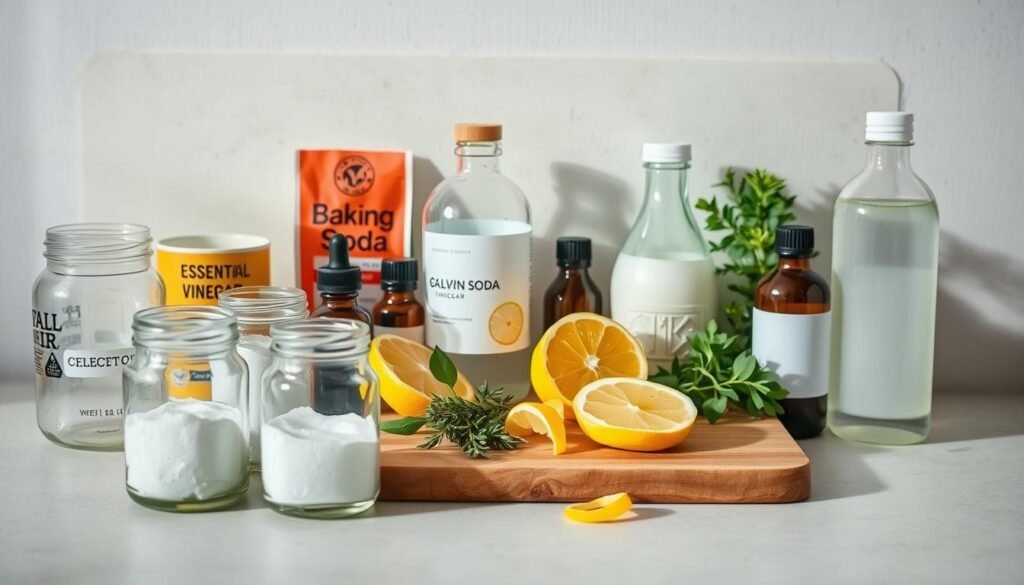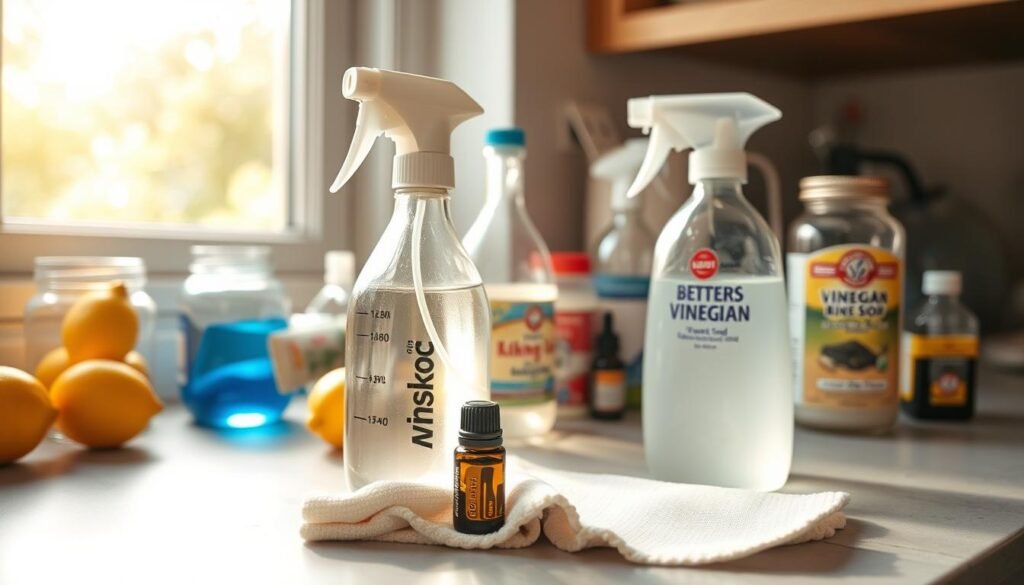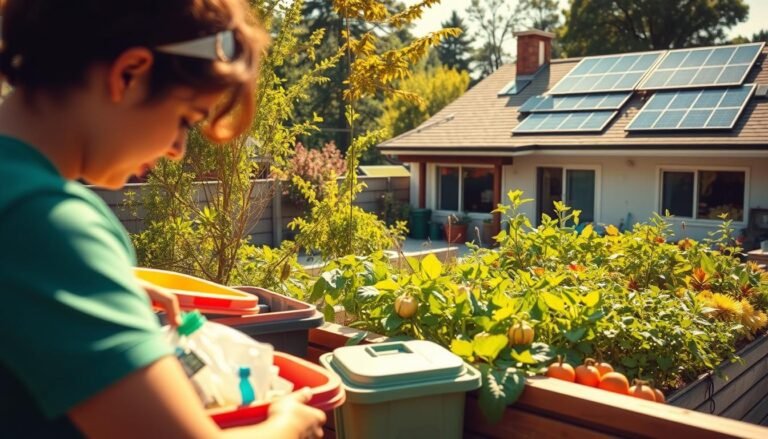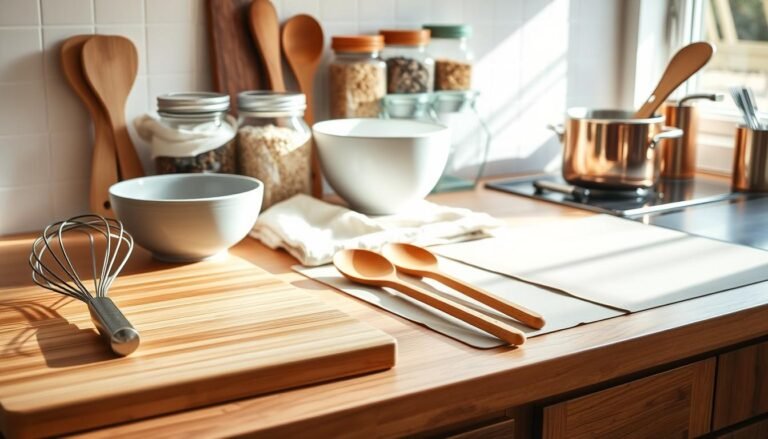Switching to homemade cleaners is a simple yet effective way to reduce your exposure to harsh chemicals and create a healthier home environment. Commercial cleaning products often contain a cocktail of toxic substances that can harm your family’s health and the environment. By making your own eco-friendly cleaning solutions, you can ensure a cleaner, greener home.
For more inspiration, you can explore a variety of homemade all-natural cleaning recipes that are easy to make and effective. These recipes use common household ingredients to create effective cleaning solutions.
Key Takeaways
- Reduce exposure to harsh chemicals with homemade cleaners.
- Create effective cleaning solutions using common household ingredients.
- Make your own eco-friendly cleaning products for a healthier home.
- Explore a variety of homemade all-natural cleaning recipes.
- Switch to non-toxic cleaning alternatives for a greener home.
The Hidden Dangers of Commercial Cleaning Products
The use of commercial cleaning products in Australian homes poses significant health and environmental concerns. While these products are designed to clean and disinfect, many contain harsh chemicals that can have unintended consequences on our health and the environment.
Common Toxic Ingredients to Avoid
Many commercial cleaning products contain toxic ingredients such as ammonia, chlorine, and phthalates. These chemicals can cause respiratory issues, skin irritation, and other health problems. For instance, ammonia can release fumes that irritate the eyes, nose, and throat, while chlorine can react with other substances to form harmful compounds.
When shopping for cleaning products, it’s essential to read the labels carefully and avoid products containing these harmful chemicals. Opting for products with natural ingredients or making your own cleaning solutions can significantly reduce exposure to toxins.
Health Impacts of Chemical Cleaners
The health impacts of chemical cleaners can be significant, ranging from mild irritation to serious conditions. Exposure to harsh chemicals in cleaning products has been linked to respiratory problems, skin conditions, and even certain types of cancer. Moreover, the indoor air quality in homes can be compromised, leading to a range of health issues.
By switching to natural cleaning products or DIY cleaning recipes, households can reduce their exposure to these harmful substances, creating a healthier living environment for their families.
Benefits of Switching to Natural Cleaning Products DIY Recipes
Switching to natural cleaning products DIY recipes can significantly improve your home’s health and environmental sustainability. By making your own cleaning products, you can avoid the harsh chemicals found in many commercial cleaners.
Health Advantages for Your Family
Using natural cleaning products DIY recipes can greatly benefit your family’s health. Commercial cleaning products often contain toxic chemicals that can cause respiratory issues, skin irritation, and other health problems. In contrast, natural ingredients like vinegar, baking soda, and lemon are gentle on surfaces and safe for your family.
Naturally made cleaning products also reduce the risk of accidental poisoning, especially among children and pets who may ingest or come into contact with cleaning supplies.
Environmental Benefits for Australian Ecosystems
Natural cleaning products DIY recipes are not only better for your health, but they’re also more environmentally friendly. Commercial cleaning products can pollute waterways and harm aquatic life when washed down the drain. In contrast, natural ingredients are biodegradable and non-toxic, making them a safer choice for Australian ecosystems.
By choosing natural cleaning products, you’re contributing to a reduction in chemical pollution and helping to protect Australia’s unique wildlife.
Cost Savings in the Australian Market
Another significant benefit of natural cleaning products DIY recipes is the cost savings. Making your own cleaning products can be significantly cheaper than buying commercial cleaners, especially when you use pantry staples like vinegar and baking soda.
By adopting natural cleaning products DIY recipes, Australian households can save money on cleaning supplies while also reducing their environmental footprint.
Essential Ingredients for Homemade Cleaners
Creating effective homemade cleaners starts with understanding the essential ingredients that make them work. The right combination of natural ingredients can make a significant difference in the cleanliness and healthiness of your home.
Pantry Staples
Many effective cleaning ingredients are already in your pantry. Vinegar, for instance, is a versatile cleaner and disinfectant due to its acidity. Baking soda is another staple that acts as a gentle abrasive and odor absorber. Lemon juice is also a common ingredient, providing a natural bleaching agent and a fresh scent.
These pantry staples can be used in various combinations to create a range of cleaning products. For example, mixing baking soda and vinegar creates a paste that can be used to clean surfaces and unclog drains.

Australian Native Essential Oils for Cleaning Power
Australian native essential oils not only provide a pleasant aroma but also offer significant cleaning benefits. Let’s explore some of the most effective options:
Eucalyptus Oil Applications
Eucalyptus globulus oil is known for its decongestant properties and is often used in cleaning products for its fresh scent and ability to combat grease.
Tea Tree Oil Benefits
Tea tree oil, derived from Melaleuca alternifolia, is renowned for its antimicrobial properties, making it an excellent ingredient for homemade disinfectants.
Lemon Myrtle Properties
Backhousia citriodora, or lemon myrtle, offers a strong citrus scent and is used for its preservative qualities and fragrance.
| Ingredient | Properties | Uses |
|---|---|---|
| Vinegar | Acidic, antimicrobial | Disinfecting, degreasing |
| Baking Soda | Abrasive, odor absorber | Scrubbing, deodorizing |
| Eucalyptus Oil | Decongestant, fragrant | Air freshening, grease cutting |
| Tea Tree Oil | Antimicrobial | Disinfecting, antiseptic |
Where to Source Quality Ingredients in Australia
Quality ingredients can be sourced from various suppliers across Australia. Health food stores, specialty kitchen stores, and online retailers often carry a range of natural cleaning ingredients. When shopping, look for products that are labeled as ‘pure’ or ‘undiluted’ to ensure you’re getting the most effective ingredient for your homemade cleaners.
Basic Equipment Needed for DIY Cleaning Products
Before you begin mixing your own natural cleaning solutions, it’s crucial to have the right equipment on hand. Having the proper tools and supplies will make the process easier and more efficient.
Containers and Spray Bottles
You’ll need containers to store your homemade cleaners. Glass jars and spray bottles are ideal for most DIY cleaning products. Look for bottles with labels or label them yourself to keep track of what’s inside. Consider using recycled containers to reduce waste.
- Glass jars for storing powders and liquids
- Spray bottles for easy application
- Labelled containers for identification
Mixing Tools and Measuring Equipment
To mix your DIY cleaning products, you’ll need some basic tools. A stainless steel spoon or silicone spatula is perfect for mixing, while a measuring jug or measuring spoons will help you get the proportions right.
Labels and Storage Solutions
Once you’ve made your DIY cleaning products, you’ll need to store them properly. Use labels to identify what’s inside each container, and consider storing them in a cool, dry place or on a designated cleaning caddy. This will keep your cleaning supplies organized and within reach.
All-Purpose Cleaner Recipes
With the rise of eco-friendly living, DIY all-purpose cleaner recipes have become increasingly popular among Australian households. Making your own cleaning products at home not only reduces the use of harsh chemicals but also offers a cost-effective and customizable cleaning solution.
Here are three effective all-purpose cleaner recipes using natural ingredients that are easily available in Australia.
Citrus Vinegar Cleaner
This refreshing cleaner combines the power of citrus peels with white vinegar to create an effective cleaning agent. Simply fill a jar with citrus peels, cover them with white vinegar, and let it sit for a few weeks. Strain the mixture and use it as an all-purpose cleaner.
Benefits: Non-toxic, biodegradable, and leaves a fresh citrus scent.
Eucalyptus All-Purpose Spray
Eucalyptus oil is known for its cleansing properties. Mix eucalyptus oil with water and a small amount of washing soda to create a versatile cleaning spray. This mixture is particularly effective on surfaces that require a gentle yet potent cleaner.
Advantages: Antibacterial properties, fresh scent, and suitable for various surfaces.
Tea Tree Disinfectant Cleaner
Tea tree oil is renowned for its disinfectant properties. Combine tea tree oil with vinegar and water to create a powerful disinfectant cleaner. This recipe is ideal for high-touch areas and surfaces that require thorough sanitization.
Key Features: Disinfectant, non-toxic, and environmentally friendly.
| Recipe | Main Ingredients | Benefits |
|---|---|---|
| Citrus Vinegar Cleaner | Citrus peels, white vinegar | Non-toxic, biodegradable, fresh scent |
| Eucalyptus All-Purpose Spray | Eucalyptus oil, water, washing soda | Antibacterial, fresh scent, versatile |
| Tea Tree Disinfectant Cleaner | Tea tree oil, vinegar, water | Disinfectant, non-toxic, environmentally friendly |
“The best way to get started is to quit talking and begin doing.”
By incorporating these natural all-purpose cleaner recipes into your cleaning routine, you not only contribute to a healthier home environment but also support eco-friendly practices.
Kitchen Cleaning Solutions
Kitchen cleaning solutions don’t have to be harsh or chemical-laden; natural ingredients can be just as effective. The kitchen is a high-traffic area that requires regular cleaning to maintain hygiene and prevent the buildup of grime and bacteria.
Natural Degreaser Recipe
A natural degreaser is essential for tackling grease on kitchen surfaces. To make one, mix 1 cup of water, 1/2 cup of white vinegar, and 1 tablespoon of baking soda in a spray bottle. Shake well before each use. This degreaser is effective on countertops, sinks, and stovetops.
Benefits of Natural Degreaser: It’s non-toxic, environmentally friendly, and cost-effective.
Homemade Dishwashing Liquid
Creating your own dishwashing liquid is simple and allows you to avoid harsh chemicals found in many commercial products. Mix 1 cup of washing soda, 1/2 cup of castile soap, and 2 cups of hot water. Add a few drops of lemon essential oil for a fresh scent.
- Eco-friendly ingredients
- Gentle on hands
- Effective at cutting grease
Oven and Stovetop Cleaners
For tough oven grime, a paste made from baking soda and water can be very effective. Apply the paste to the interior of the oven and let it sit overnight before wiping clean. For stovetops, a mixture of equal parts water and white vinegar in a spray bottle can help dissolve grime.
| Cleaning Task | Natural Solution |
|---|---|
| Degreasing | Vinegar and Baking Soda Mix |
| Dishwashing | Castile Soap and Washing Soda |
| Oven Cleaning | Baking Soda Paste |
By adopting these natural kitchen cleaning solutions, you not only create a healthier environment for your family but also contribute to a more sustainable future.
Bathroom Cleaning Recipes
Bathroom cleaning is an essential chore that can be made easier and safer with DIY natural cleaning recipes. Using natural ingredients not only helps in maintaining a clean and hygienic bathroom but also ensures that your family is not exposed to harsh chemicals.
Toilet Bowl Cleaner
A clean toilet bowl is crucial for a hygienic bathroom. To make a natural toilet bowl cleaner, mix 1 cup of baking soda with 1/2 cup of white vinegar and 10 drops of tea tree oil. Pour the mixture into the toilet bowl and scrub with a toilet brush. Let it sit for 10 minutes before flushing. This natural cleaner is effective in removing stains and odors.
Benefits: This recipe is not only effective but also environmentally friendly and safe for your family.
Shower and Tile Scrub
Soap scum and mildew can make your shower and tiles look dirty. To combat this, mix 1 cup of baking soda with 1/2 cup of white vinegar to form a paste. Apply the paste to the shower and tiles, scrub with a non-abrasive sponge, and rinse with warm water. For tougher grime, let the paste sit for 15-20 minutes before scrubbing.
“Using natural ingredients for cleaning can significantly reduce our exposure to toxic chemicals.”
Mould and Mildew Solutions for Humid Australian Bathrooms
Mould and mildew thrive in humid environments, making Australian bathrooms prone to these issues. To prevent mould and mildew, mix equal parts water and white vinegar in a spray bottle. Spray the solution onto affected areas and let it sit for 10-15 minutes before wiping clean. Tea tree oil can also be added for its antifungal properties.
- Spray the solution onto mould and mildew areas.
- Let it sit for 10-15 minutes.
- Wipe clean with a damp cloth.
By incorporating these natural bathroom cleaning recipes into your cleaning routine, you can maintain a clean, healthy, and fresh bathroom without exposing your family to harsh chemicals.
Floor Cleaning Formulas for Different Surfaces
When it comes to floor cleaning, one size doesn’t fit all. Different flooring types require specific cleaning approaches to maintain their durability and appearance. In this section, we’ll explore effective and natural cleaning formulas for various floor surfaces commonly found in Australian homes.
Timber Floor Cleaner
Timber floors add warmth and character to any home, but they require gentle care. A simple and effective timber floor cleaner can be made by mixing 1 cup of warm water with 1/4 cup of white vinegar and 1 tablespoon of olive oil. This solution cleans the floor while nourishing the timber. Dampen a mop with the solution and gently clean the floor, working with the grain.
Tile and Laminate Floor Solution
Tile and laminate floors are durable and easy to maintain. For a effective cleaning solution, combine 1 cup of warm water, 1/4 cup of white vinegar, and 1 teaspoon of mild dish soap. This formula is gentle on the surface while effectively removing dirt and grime. For tougher stains, add a sprinkle of baking soda before scrubbing.
Carpet Freshener and Stain Remover
Carpets can harbor odors and stains, but natural ingredients can help. To freshen and clean your carpet, mix 1 cup of warm water with 1 tablespoon of white vinegar, 1 tablespoon of baking soda, and 1 teaspoon of essential oil (like tea tree or lavender). Apply the solution to the stained area, let it sit for a few minutes, then blot with a clean cloth. For tougher stains, repeat the process before rinsing with cold water.
Window and Glass Cleaning Recipes
Say goodbye to streaks and grime on your windows and glass with our effective natural cleaning solutions. Cleaning windows and glass surfaces can be challenging, but with the right ingredients, it’s a breeze.
Streak-Free Glass Cleaner
A streak-free glass cleaner is a must-have for any homeowner. To make one, mix 1 cup of water, 1/2 cup of white vinegar, and 1 tablespoon of cornstarch in a spray bottle. Shake well and spray onto glass surfaces. Wipe clean with a lint-free cloth or paper towel for a sparkling finish.
This recipe is effective because the cornstarch helps prevent streaks, while the vinegar cuts through grime and dirt.
Mirror and Chrome Polish
For mirrors and chrome fixtures, a shiny, smudge-free finish can be achieved with a simple mixture of equal parts water and white vinegar in a spray bottle. Add a few drops of lemon essential oil for a fresh scent. Spray onto the surface and wipe clean with a microfiber cloth.

| Ingredient | Purpose | Effectiveness |
|---|---|---|
| White Vinegar | Cuts through grime and dirt | High |
| Cornstarch | Prevents streaks | High |
| Lemon Essential Oil | Adds a fresh scent | Medium |
Seasonal Cleaning Solutions for Australian Homes
With Australia’s varied seasonal conditions, it’s essential to adapt cleaning routines to maintain a clean and healthy home. Different seasons bring unique cleaning challenges, from the dust and heat of summer to the dampness of winter and the renewal of spring.
Summer Cleaning Challenges and Solutions
Summer in Australia can be particularly harsh, with high temperatures and humidity levels leading to dust accumulation and the growth of mould and mildew. Effective summer cleaning involves tackling these issues head-on.
Dealing with Beach Sand and Saltwater Residue
For those living near the coast, beach sand and saltwater residue can be a significant challenge. A simple solution is to use a mixture of baking soda and vinegar to clean surfaces and remove salt residue. This natural combination is effective and gentle on surfaces.
Natural Insect Repellent Cleaners
Summer also brings insects, which can be repelled using natural cleaners. Essential oils like citronella and lemongrass can be mixed with water and vinegar to create an effective insect repellent spray.
Winter Dampness and Mould Prevention
Winter brings its own set of challenges, primarily dampness and mould. To combat this, ensure good ventilation in your home and use a natural mould-fighting cleaner made from tea tree oil and vinegar. This combination is potent against mould and mildew.
Spring Cleaning the Aussie Way
Spring is the perfect time for a deep clean. Focus on areas that were neglected during the winter months, and consider using natural cleaning products to refresh your home. A lemon and baking soda scrub is excellent for tackling tough grime and leaving surfaces clean and fresh.
By adapting your cleaning routine to the changing seasons and using natural, effective cleaning solutions, you can keep your Australian home clean, healthy, and welcoming all year round.
Outdoor and Patio Cleaning Recipes
With the arrival of spring, it’s the perfect time to give your outdoor and patio areas a thorough clean using natural ingredients. Outdoor and patio cleaning can be a daunting task, but with the right recipes, it becomes manageable and eco-friendly.
BBQ and Outdoor Kitchen Cleaners
Cleaning your BBQ and outdoor kitchen is crucial for hygiene and to prevent the buildup of grime. A simple recipe involves mixing baking soda, vinegar, and lemon juice to create a paste that can tackle tough stains.
- 1 cup baking soda
- 1 cup vinegar
- 2 tablespoons lemon juice
Apply the paste to the BBQ surfaces and let it sit for 30 minutes before scrubbing and rinsing.
Deck and Patio Natural Cleaning Solutions
For decks and patios, a natural cleaning solution can be made using essential oils, soap, and water. This mixture is gentle on surfaces yet effective against dirt and grime.
- Mix 1 tablespoon of soap with 1 liter of warm water.
- Add 10 drops of your preferred essential oil (like tea tree or lavender) for a fresh scent.
Use a soft-bristled brush to scrub the deck or patio, then rinse thoroughly with water.
Troubleshooting Common Issues with Natural Cleaners
Even with the best natural cleaners, there can be instances where they don’t quite meet our expectations. Whether it’s a stubborn stain or an ineffective formula, there are ways to address these issues.
Adjusting Recipes for Better Results
If your natural cleaner isn’t working as well as you’d like, consider adjusting the recipe. For instance, if a stain persists, you might need to increase the concentration of the active ingredient or add a different component to enhance its effectiveness. Sometimes, a simple tweak can make a significant difference.
Another approach is to experiment with different essential oils not just for their fragrance but for their cleaning properties. For example, tea tree oil is renowned for its antimicrobial properties, making it an excellent addition to disinfectant cleaners.
When to Use Commercial Products Instead
While natural cleaners are effective for many tasks, there are situations where commercial products might be more appropriate. For heavily contaminated areas or surfaces that require intense disinfection, commercial-grade disinfectants might be necessary to ensure thorough cleanliness and safety.
It’s also worth considering that some surfaces may react adversely to certain natural ingredients. In such cases, opting for a commercial product specifically designed for that surface can prevent damage and ensure a better outcome.
Conclusion
Switching to natural cleaning products DIY recipes is a simple yet effective way to create a healthier home environment in Australia. By avoiding harsh chemicals found in commercial cleaning products, you can protect your family’s health and contribute to a more sustainable future.
The recipes and tips provided throughout this article demonstrate how easy it is to make effective cleaning products using natural ingredients. From all-purpose cleaners to specialized solutions for kitchens and bathrooms, you can create a comprehensive cleaning arsenal that’s both non-toxic and environmentally friendly.
As you begin your journey with natural cleaning products DIY recipes, you’ll not only be reducing your exposure to harmful chemicals but also saving money and minimizing your environmental footprint. So, start experimenting with these recipes, adjust them to suit your needs, and enjoy the peace of mind that comes with knowing you’re creating a cleaner, greener home for you and your loved ones.





